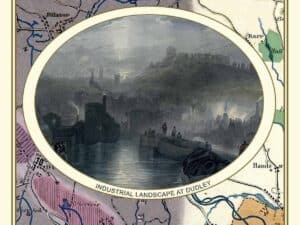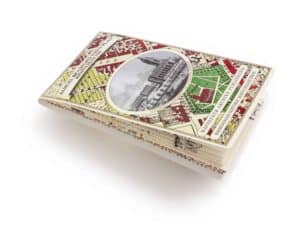Description
The 1901 Football Showdown: Aston Villa vs. Small Heath
In the heart of Birmingham, on Boxing Day, Thursday, December 26, 1901, in front of a sell out 40,000 capacity crowd, a historic football rivalry ignited between Aston Villa and Small Heath (now Birmingham City). This local derby would go down in history as one of the most memorable clashes of the early 20th century, showcasing the intense rivalry that continues to this day.
A Tale of Two Teams
At the time, Aston Villa was the dominant force in English football. The club had already clinched the First Division title five times, and won the FA Cup three times by 1901. Under the management of George Ramsay, Villa’s reputation for fluid, attacking football, made them a powerhouse to be recognised in the Football League.
Small Heath, on the other hand, was still building its legacy. The club had just been promoted to the First Division, but lacked Villa’s pedigree. However, this underdog status only fueled the fire when the two sides met, as Small Heath was determined to prove themselves against their established neighbors, especially after they had been knocked out of the FA Cup replay earlier that year on March 26th at Villa Park, following a goalless draw at the Small Heath ground.
Match Day Atmosphere
It was only during the early years of the 1900’s that the football ground, opened in 1897, gradually became known as Villa Park. This match, now captured for prosperity through this photographic image from that very day, at Aston Villa’s home ground, captivates the electric anticipation of the sell out crowd. The rivalry between these clubs extended beyond football – it was a clash of identities, the match day turf extended beyond the pitch.
This made the fixture more than just a football match; it was a battle for local pride, local turf and district identity.
The capacity 40,000 crowd shoe horned into the Aston Villa ground, eager to witness the spectacle. Football in the early 1900s had a raw, unfiltered energy, with fans standing shoulder to shoulder, shouting encouragement or jeers at their favourite (or least favourite) players.
The Game Itself
Aston Villa, as expected, started the game with confidence. Their star players, including, Howard Spencer and Billy Garraty, controlled possession and kept the pressure on Small Heath’s defence. However, Small Heath, aware of Villa’s attacking prowess, adopted a physical, resilient style of play, frustrating their more accomplished rivals.
Despite Aston Villa’s attacking attempts, Small Heath’s defence, led by the likes of Tommy Hands and goalkeeper Nat Robinson, held firm, turning the match into a battle of attrition. It became a gritty contest, with both sides struggling to break the deadlock. Villa’s passing and movement were met with fierce challenges, and Small Heath’s counter-attacks tested Villa’s defence, though chances remained scarce. This image captures the moment all of the Aston Villa team were desperately defending their 16 yard line with vigor, with the Villa goalkeeper, Billy George, standing firm fast in anticipation.
Billy George went on to play for England in goal, for two matches the following year, he was born in June 1874, the same year of the founding of Aston Villa Football Club,
The Decisive Moment
For most of the hard-fought 90 minutes, neither side could find the back of the net. The match ended in a 1-0 Aston Villa victory, a result that favoured Aston Villa more than Small Heath. For Villa, the win felt like an opportunity to assert their dominance over their local rivals. For Small Heath, it was a moment of frustration. The winning goal was scored by the Villa Forward, only signed by the Villa that year, Jasper McLuckie, who went on to score many goals for the club before joining
Plymouth – Agyle in 1904.
The Aston Villa Team
Goalkeeper – Billy George – Defender – Alf Wood – Full Back – George Shutt – Midfielder – Tom Perry – Midfielder – Jimmy Crabtree – Midfielder – Albert Wilkes – Winger – Billy Marriot – Winger – Willie Clarke – Forward – Jasper McLuckieForward – Joe Bache – Centre Forward – Billy Garraty
Legacy of the 1901 Derby
Regardless of the match result, it cemented territorial fierce rivalry between Aston Villa and Small Heath, a rivalry that continues over a century on as the famous “Second City Derby” between Aston Villa and Birmingham City.
The 1901 clash was a turning point in Small Heath’s footballing journey. Though Villa would continue to dominate English football in the years to come, Small Heath’s performance in this match showed that they could stand up to their illustrious neighbours. It gave the supporters of Small Heath a sense of pride and fuelled the ongoing competition between the two clubs.
Relive the Moment with an Exclusive Print from Mapseeker Digital
While modern football is a global spectacle, there’s something magical about revisiting those gritty, passionate games from a bygone era. And now, you can own a piece of this historic rivalry through this previously unpublished rare archive, from Mapseeker Digital Ltd, World-renowned suppliers of digitally re-mastered rare archive maps, prints and vistas. This is an exclusive, highly detailed black and white match-action print, capturing the 1901 Aston Villa vs. Small Heath Division One game. This stunning print captures the raw energy and atmosphere of the day, bringing to life the very essence of this intense local derby.
Whether you’re a Villa or Birmingham City fan, or just a lover of football history, this rare piece is a must-have. Don’t miss your chance to relive the action and own a true piece of Birmingham football heritage.
Conclusion
Though the 1901 derby ended in a 1-0 victory for Villa, it was a hard-fought contest that symbolised the rivalry and spirit of the game during that era. The history lives on through moments like these, and with Mapseeker Digital’s exclusive print, you can keep that history alive on your walls. Today, Aston Villa and Birmingham City remain fierce rivals, and the memory of those early matches continues to shape football folklore.








Reviews
There are no reviews yet.